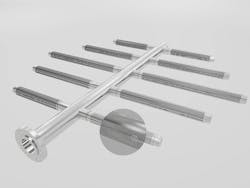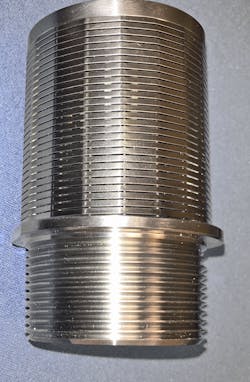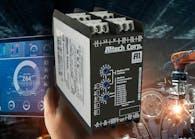Many industries use media-bed filtration. This use may take the form of ion exchange for water softening/demineralization, sand filtration, activated carbon or other media bed fluid treatment processes. However, no matter if the application is in a water utility, a power utility, pulp and paper, steel, or any other industry, problems tend to be similar. Time and again, the same common complaints arise in the media bed filtration process: leaking resin or media, excessive pressure drop, screen clogging and excessive backwash/rejuvenation requirements. These problems can be solved by the use of properly designed and specified equipment and equipment internals (arguably the most important investment in media bed filtration). Unfortunately, most new equipment and retrofit inquiries do not include enough hard and specific data to ensure the proper product selection.
Understand the system
To ensure a proper design outcome, a design engineer needs to know the system pressures. ls it designed to avoid clogging? In the event of hydraulic failure, will it withstand the strain it is likely to experience and yet still retain the media? ls it sized to retain the particles in normal use? Will it pass the desired flow? ls it designed to provide a pressure differential to ensure uniform flow? Has corrosion been considered? Are proper alloys available and specified? Can it be successfully backwashed on a repetitive basis without clogging?
A typical inquiry to the filtration product manufacturer might ask for a set of "header laterals" to form a distribution system for an activated carbon column or demineralizer tank. The manufacturer may be supplied with a request for a lateral distribution/collection system. Given the flow data and vessel particulars, this data can certainly be used to produce a set of header laterals. ln fact, a great variety of header laterals might be produced that all conform to these specifications. The question is: Which design would do the best job for the specifier? Although the term header lateral is commonly used, the process may be better served and more economical with other configurations such as a "hub lateral" system, "drop-leg nozzle" configurations as well as others. In the ideal situation, the manufacturer’s application engineers will return to their customer with a set of questions designed to elicit more specific information about the customer’s overall requirements. For example, they may want to discuss the media bed filtration process to make certain the process is understood and the critical areas are fully considered. Initial understanding of the process particulars like these are paramount to reduce overall maintenance and costs and obtain an optimal product.
Wedge wire benefits & applications
Wedge wire is often recommended for its strength and cleaning ease. It can be supplied in many forms used in distribution/collection systems, nozzle and lateral configurations being the most common. Laterals can be supplied with many end configurations to suit. Commonly, wedge wire is applied over a drilled pipe. This design offers improved support and allows for engineered drill patterns that ensure the best possible distribution and collection, affording maximum bed utilization.
All of the above is based on an accurate determination of the media retention requirements. The slot size of the wedge wire product is crucial to ensure all of the efforts of analysis, design and methods of fabrication are realized. Many of the wedge wire products on the market are still based on the original well drilling usage as far as tolerances are considered. They are often manufactured with a retentive slot size tolerance of +/- 0.002 inch or greater. The results are obvious when trying to retain ion exchange media of 0.010 inch. Modern Computer Numeric Control (CNC) machinery and International Organization for Standardization (ISO) quality procedures can result in tolerances of +/- 0.001 inch and better.
Channeling is the enemy
In any process where a fluid is distributed through media, channeling must be eliminated. It is important to retain the uniform distribution as stated above, directing the fluid to flow uniformly through the bed and to maximize the media contact. Channeling is always the enemy. Channeling leads to premature media exhaustion and a need for premature regeneration. Vessel internals therefore determine flow characteristics and the ultimate performance of the process. Technology-oriented manufacturers use electronic design automation (EDA) to supply the answers. Specific considerations such as screen opening size in water treatment processes, as in ion exchange, are crucial. The function of the screen is to keep the resin beads in place while facilitating fluid flow through the bed.
Wedge wire filter nozzle
Materials of construction
Materials of construction need to be addressed as well. The typical liquid "seen" by a filtration system is water. It can be wastewater or boiler feed water, river water, brackish water, seawater or ultrapure water. In the process industries, filtration may also involve a variety of chemicals. Fortunately, most of these fluids can be handled by elements made of the appropriate stainless steel, nickel alloy or duplex alloy. The customer should make sure the supplier can provide a material that functions well with the specific system fluid used. Filtration systems are also supplied with PVC laterals slotted to retain the media. PVC offers good corrosion resistance but poor structural stability. Pressure variations tend to cause the plastic to flex, altering slot size and configuration. PVC is also subject to abrasion altering retention, which can result in media loss or even total failure.
Wire cloth screening is also often used with good results in filtration applications, but it does not provide the reliability of wedge wire. Because the cross section of wires that makes up the mesh is round, a tendency for particles to lodge and clog always exists. Wedge wire is fabricated using a triangular-shaped wire wrapped continuously over longitudinal support wires. The wires are welded at each intersection. The triangular, cross-section wedge wire with a flat retention surface is more easily and more effectively cleaned and backwashed. ln addition, water pressures, system stresses and careless handling can cause abrasions or tears in the wire cloth. For these reasons, many engineers prefer the strength, clog-resistance, ease of backwashing and dimensional stability of wedge wire.
Many systems also employ downstream protection in the form of basket strainers or resin traps. Wedge wire is also an ideal filter media for this application. Strong and rigid, retention is maintained as process conditions vary. The nature of wedge wire construction lends itself to scrubbing, cleaning and washing without damage. Baskets can be designed to accommodate line size, pressure drop requirements, varying configurations and process conditions.
The result is that wedge wire has provided engineers a superior retention media with which to design and manufacture vessel internals, resin traps as well as other filtration products with long-term savings and efficiencies.
E. Marvin Greenstein is director of engineering at Newark Wire Cloth Co. Inc. He is considered an expert in engineered filtration products serving the water, waste, utility and power generation industries. He has published articles on the design of vessel internals for media bed filtration. Greenstein holds a Bachelor of Science in chemical engineering and is a member of the A.I.Ch. Engineers. He may be reached at [email protected]. For more information about wedge wire products, visit newarkwire.com.



